6 Best Homemade Meat Dog Food Recipes (Pups Love!)
Look, I get it. You’re standing in the pet food aisle, squinting at ingredient lists that look like chemistry experiments, wondering if there’s a better way to feed your furry best friend. Well, guess what? There totally is! Making homemade meat dog food isn’t just some trendy thing – it’s actually one of the best decisions you can make for your dog’s health and happiness.
I’ve been down this road myself, and let me tell you, watching my dog’s energy levels skyrocket and coat get shinier was worth every minute I spent in the kitchen. Plus, you’ll actually know what’s going into your pup’s bowl – no mysterious “meat by-products” or unpronounceable chemicals. In this guide, I’ll share 6 proven homemade meat dog food recipes that have worked wonders for countless pups, plus all the tips you need to get started safely.
Table of Contents
Why Your Dog Deserves Better Than Store-Bought
Ever wonder why your dog gets so excited about table scraps but seems meh about their kibble? It’s because real food just tastes better – and it’s better for them too.
Commercial dog food problems you’ve probably noticed:
- Fillers that add zero nutritional value
- Preservatives with names you can’t pronounce
- “Meat meals” that could be anything
- Sky-high prices for premium brands
Your dog’s ancestors didn’t survive on processed pellets, and honestly, neither should your modern pup. High-protein dog meals made with real meat provide the nutrients dogs actually need to thrive.
The Science Behind Meat-Based Dog Nutrition
Dogs are carnivores at heart – their digestive systems are designed to process meat efficiently. When you make DIY meat dog food, you’re giving them exactly what their bodies crave.
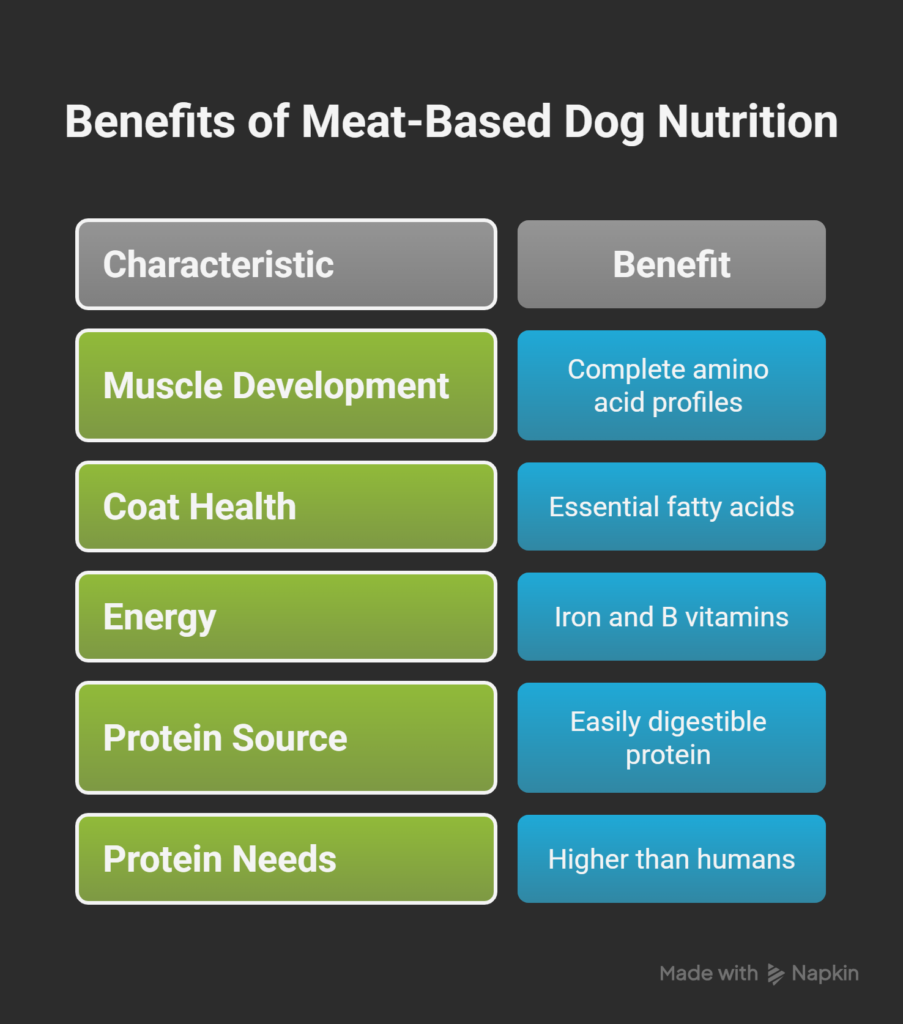
What meat brings to the table:
- Complete amino acid profiles for muscle development
- Essential fatty acids for coat health
- Iron and B vitamins for energy
- Easily digestible protein sources
The protein requirements for dogs are significantly higher than humans – they need about 18-25% of their calories from protein (compared to our measly 10-15%). Store-bought foods often fall short, but homemade meat dog food recipes let you control exactly how much high-quality protein your pup gets.
Choosing the Right Meat for Your Dog
Not all meat is created equal when it comes to canine nutrition. I’ve experimented with various proteins over the years, and here’s what I’ve learned works best.
Best Meat Options for Dogs
- Beef, in addition to being high in protein, contains vital minerals like iron and zinc.
- Turkey is fantastic for dogs with chicken allergies and offers similar nutritional benefits with a different flavor profile.
- Lamb works great for dogs with multiple protein sensitivities and provides unique nutrients not found in more common meats.
- Fish (salmon, sardines) bring omega-3 fatty acids to the party, supporting brain and coat health.
- Chicken remains the gold standard – it’s affordable, widely available, and most dogs love it. Plus, it’s lean and easy to digest.
Meats to Approach Carefully
Pork can be used, but choose lean cuts and cook thoroughly. Some dogs have trouble digesting it.
Organ meats are nutritional powerhouses, but should only make up 5-10% of the meal – too much can cause digestive upset.
Essential Ingredients Beyond Meat
Meat food for dogs needs more than just protein to be complete. Think of it like building a balanced meal for yourself – you wouldn’t eat just steak, right?
Carbohydrate Sources
- Brown rice: Easy to digest and provides steady energy
- Sweet potatoes: Packed with vitamins and fiber
- Quinoa: A Complete protein source that complements meat
- Oats: Great for dogs with sensitive stomachs
Vegetable Additions
- Carrots: Beta-carotene for eye health
- Green beans: Low-calorie fiber source
- Peas: A Natural source of protein and vitamins
- Spinach: Iron and folate (use sparingly)
Healthy Fats
- Coconut oil: Supports the immune system
- Fish oil: Omega-3 fatty acids for coat health
- Olive oil: Antioxidants and healthy fats
Overview of the 6 Best Homemade Meat Dog Food Options

When it comes to creating nutritious homemade meat dog food, having a variety of protein sources ensures your pup gets diverse nutrients while preventing food boredom. Here are the six most effective combinations that have proven successful for countless dogs.
Chicken-Based Homemade Meat Dog Food
Chicken remains the most popular choice for homemade meat dog food because it’s lean, affordable, and well-tolerated by most dogs. This protein source provides complete amino acids and is perfect for dogs with sensitive stomachs. Pairing chicken with wholesome carbohydrates like brown rice creates a balanced foundation that most dogs love.
The beauty of chicken-based homemade meat dog food lies in its versatility. You can use ground chicken, chicken thighs, or even chicken breast, depending on your dog’s fat tolerance and preferences.
Beef-Based Homemade Meat Dog Food
Beef offers a robust protein profile that’s ideal for active dogs needing extra energy. This type of homemade meat dog food provides essential minerals like iron and zinc that support immune function and muscle development. When combined with nutrient-dense vegetables, beef creates hearty meals that satisfy even the most energetic dogs.
Ground beef works wonderfully for homemade meat dog food, though choosing leaner cuts helps prevent digestive upset in sensitive dogs.
Turkey-Based Homemade Meat Dog Food
Turkey serves as an excellent alternative protein for dogs with chicken allergies or sensitivities. This lean meat creates easily digestible homemade meat dog food that’s perfect for dogs transitioning from commercial kibble. Turkey’s mild flavor makes it appealing to picky eaters while providing high-quality protein.
Many pet parents find turkey-based homemade meat dog food particularly beneficial for senior dogs who need gentle, easily processed nutrition.
Pork-Based Homemade Meat Dog Food
While less common, pork can create delicious homemade meat dog food when prepared properly. Lean pork provides different amino acids than chicken or beef, adding variety to your dog’s protein rotation. This option works well for dogs who’ve become bored with traditional protein sources.
Always ensure pork is thoroughly cooked when making homemade meat dog food, as proper preparation is essential for safety.
Lamb-Based Homemade Meat Dog Food
For dogs with numerous food allergies, lamb provides a unique protein source. This type of homemade meat dog food is often recommended by veterinarians for elimination diets. Lamb provides unique nutrients not found in more common meats, making it valuable for dogs with specific dietary needs.
The rich flavor of lamb-based homemade meat dog food often appeals to dogs who’ve lost interest in their regular meals.
Venison-Based Homemade Meat Dog Food
The best new protein for making homemade meat dog food is venison. This lean, wild game meat is perfect for dogs with severe allergies or those needing truly unique protein sources. Venison provides exceptional nutrition while being naturally free from common allergens found in farm-raised meats.
Creating venison-based homemade meat dog food requires careful sourcing, but the results are worth the effort for dogs with complex dietary needs.
Nutritional Balance: Getting It Right

Making meat dog food recipes isn’t just about throwing ingredients together – you need the right ratios to keep your pup healthy long-term.
The 40-30-30 Rule
A good starting point for homemade dog food:
- 40% high-quality protein (meat, fish, eggs)
- 30% vegetables (variety is key)
- 30% carbohydrates (brown rice, sweet potato, etc.)
Essential Supplements
Even the best homemade meals might need a little boost:
- Calcium: Especially important if you’re not including bones
- Fish oil: For omega-3 fatty acids
- Multivitamin: Insurance against nutritional gaps
Pro tip: Talk to your vet about supplements. Every dog’s needs are different, and what works for my German Shepherd might not be perfect for your Chihuahua.
Food Safety and Storage Guidelines for Homemade Meat Dog Food

When preparing homemade meat dog food, following proper food safety protocols is just as important as nutritional balance. Raw meat carries bacterial risks that can affect both you and your pup.
Safe Preparation Practices
Kitchen hygiene basics:
- Hands should always be thoroughly cleaned before and after handling raw meat.
- Use separate cutting boards for meat and vegetables
- Clean all surfaces with a bleach solution after prep
- Cook meat until the internal temperature reaches the proper level (165°F for poultry, 160°F for ground meat).
Temperature control:
- Cool homemade meat dog food completely before refrigerating
- Don’t let cooked food sit at room temperature for longer than two hours.
- Use a food thermometer to verify cooking temperatures
- Thaw frozen portions in the refrigerator, never on the counter
Storage Solutions That Work
Refrigerator storage:
- Store homemade dog meat food in airtight containers
- Label containers with preparation dates
- Use glass containers when possible to avoid plastic absorption
- Keep homemade meals on shelves, not in door compartments
Freezer organization:
- Portion meals into single-serving sizes before freezing
- Make use of long-term storage containers or freezer-safe bags.
- To avoid freezer burn, eliminate as much air as you can.
- Create a rotation system with the oldest meals used first
Thawing methods:
- Plan ahead and thaw overnight in the refrigerator
- For quicker thawing, submerge sealed containers in cold water
- Never microwave homemade meat dog food, as it creates hot spots
- Use thawed portions within 24 hours
Customizing Recipes for Your Dog’s Specific Needs
Every dog is unique, and homemade meat dog food recipes should reflect individual requirements. Age, breed, activity level, and health conditions all influence nutritional needs.
Adjusting for Age Groups
Puppy modifications: Puppies need 25-30% more calories than adult dogs and require frequent meals. When preparing homemade meat dog food for puppies, increase the meat portion to 50% of the recipe and add calcium supplements as recommended by your vet.
Adult dog balance: Adult dogs thrive on the standard 40-30-30 ratio mentioned earlier. Most homemade meat dog food recipes work perfectly for healthy adult dogs between 1-7 years old.
Senior dog considerations: Older dogs often need easily digestible proteins and may benefit from smaller, more frequent meals. Consider adding joint supplements to homemade meat dog food recipes and slightly reducing portions if your senior dog is less active.
Breed-Specific Modifications
Large breed considerations: Giant breeds like Great Danes and Mastiffs have specific calcium and phosphorus requirements. When making homemade meat dog food for large breeds, work with a veterinary nutritionist to ensure proper mineral ratios that support healthy bone development without causing skeletal issues.
Small breed needs: Tiny dogs have faster metabolisms and may need more frequent meals. Cut ingredients in homemade meat dog food recipes into smaller pieces to prevent choking, and consider adding healthy fats for concentrated calories.
Working dog nutrition: Active breeds like Border Collies and German Shepherds need higher protein and fat content. Increase the meat portion in homemade meat dog food recipes by 10-15% and add healthy fats like fish oil for sustained energy.
Health Condition Adaptations
Allergies and sensitivities: The beauty of homemade meat dog food is complete ingredient control. Start with novel protein sources your dog has never eaten, and introduce new ingredients one at a time to identify triggers.
Weight management: For overweight dogs, reduce the carbohydrate portion in homemade meat dog food recipes and increase low-calorie vegetables like green beans and zucchini. Maintain protein levels to preserve muscle mass during weight loss.
Digestive issues: Dogs with sensitive stomachs benefit from limited-ingredient homemade meat dog food recipes. Stick to easily digestible proteins like chicken or turkey, and avoid high-fat ingredients that might trigger upset.
The Economics of Homemade Meat Dog Food
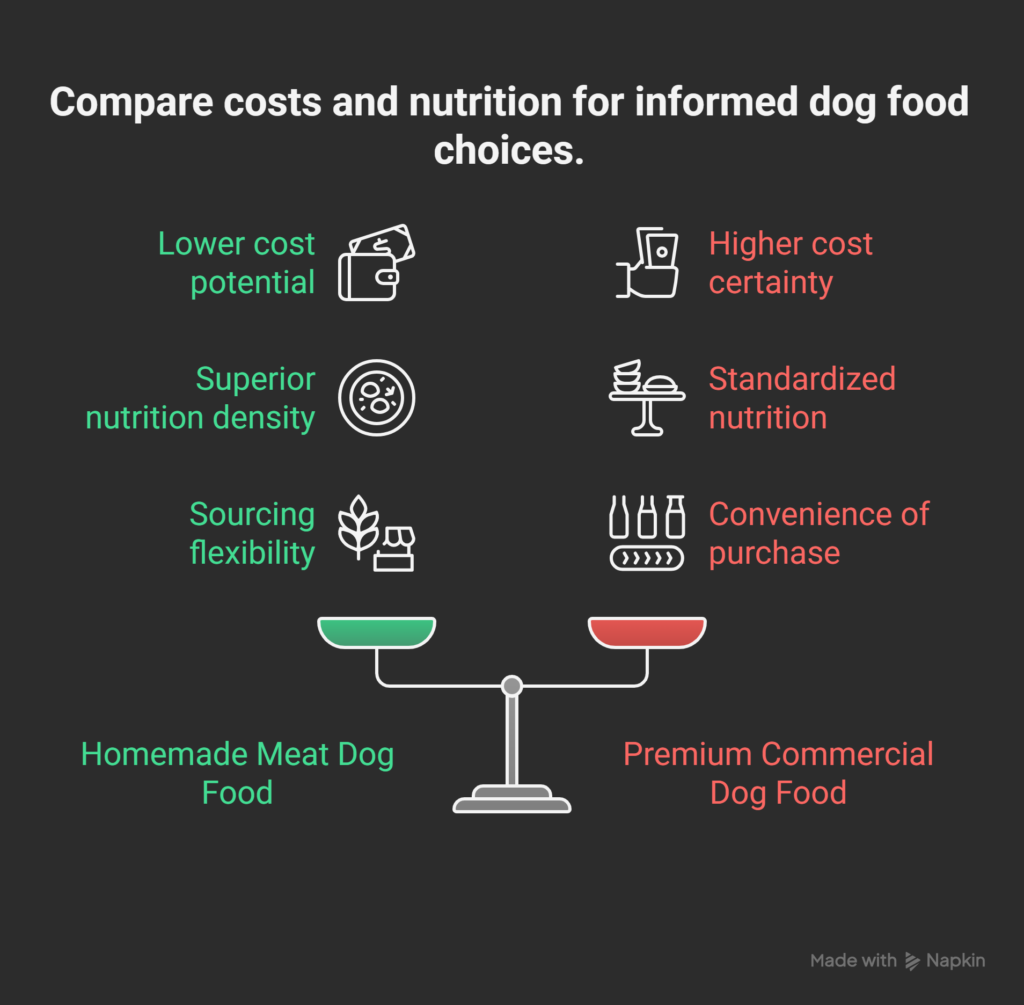
Understanding the true cost of homemade meat dog food helps you make informed decisions about your dog’s nutrition budget.
Detailed Cost Breakdown
Making homemade meat dog food is often more economical than purchasing premium commercial options, though costs vary significantly based on location, ingredient quality, and sourcing methods.
Factors affecting homemade meat dog food costs:
- Local meat prices and seasonal availability
- Organic versus conventional ingredient choices
- Bulk purchasing opportunities
- Regional agricultural pricing differences
Cost comparison considerations: When evaluating homemade meat dog food economics, compare the per-serving nutrition density rather than simple per-pound pricing. High-quality homemade meals often provide more concentrated nutrition, meaning dogs eat smaller portions while receiving superior nutritional value.
Budget-friendly strategies:
- Buy ingredients in bulk when possible
- Utilize seasonal vegetables for maximum nutrition at lower costs
- Build relationships with local farmers and butchers
- Consider less expensive cuts that require longer cooking times
Hidden Financial Benefits
Veterinary cost reductions: Dogs eating high-quality homemade meat dog food often have fewer health issues, leading to reduced vet bills. Improved digestion, better coat condition, and stronger immune systems mean fewer sick visits and medication costs.
Waste reduction benefits: Commercial dog food often contains fillers that pass through undigested. Homemade meat dog food is more nutrient-dense, meaning dogs eat smaller portions and produce less waste – savings on poop bags add up over time!
Bulk buying opportunities: Making homemade meat dog food allows you to buy ingredients in bulk when on sale. Stock up on meat when prices drop and freeze portions for later use.
Seasonal Variations and Ingredient Rotation
Keeping homemade meat dog food interesting requires variety and seasonal adaptations that mirror natural feeding patterns.

Spring Ingredients and Benefits
Fresh spring additions:
- New grass-fed meats become available
- Early vegetables like asparagus and peas
- Lighter proteins for increased activity levels
- Fresh herbs for natural detoxification
Spring cleaning for digestion: After winter’s heavier meals, spring is perfect for lighter homemade meat dog food recipes. Incorporate dandelion greens (in small amounts) and milk thistle for natural liver support.
Summer Cooling Foods
Hot weather modifications: Summer homemade meat dog food should include cooling ingredients and higher water content to prevent overheating.
Cooling ingredients to add:
- Cucumber for hydration
- Watermelon (seedless) for electrolytes
- Fish proteins instead of heavy red meats
- Frozen portions as cool treats
Fall Preparation Foods
Harvest season nutrition: Fall offers abundant squash, pumpkin, and root vegetables perfect for homemade meat dog food. These ingredients provide beta-carotene and fiber while preparing dogs for colder weather.
Building winter reserves: Gradually increase fat content in homemade meat dog food recipes as temperatures drop. In order to keep their bodies warm during the winter, dogs require additional calories.
Winter Warming Foods
Cold weather adaptations: Winter homemade meat dog food should include warming spices and higher calorie density to support dogs’ increased energy needs.
Warming ingredients:
- Ginger for circulation (small amounts)
- Cinnamon for warmth and blood sugar support
- Sweet potatoes for concentrated carbohydrates
- Fattier cuts of meat for sustained energy
Building a Support Network for Homemade Dog Food Success
Successfully maintaining a homemade meat dog food routine requires support from professionals and fellow dog parents.
Professional Team Assembly
Veterinary nutritionist consultation: Before starting any homemade meat dog food program, establish a relationship with a veterinary nutritionist. They can analyze your recipes, recommend supplements, and monitor your dog’s health progress.
Regular veterinarian check-ups: Schedule more frequent wellness visits during the first six months of feeding homemade meat dog food. Blood work can confirm that your dog is thriving on the new diet.
Emergency veterinarian awareness: Make sure your emergency vet knows your dog eats homemade meat dog food. This information can be crucial during health crises when dietary history matters.
Community Resources
Online communities: Join forums and social media groups dedicated to homemade dog food. Experienced members share recipes, troubleshooting tips, and moral support during challenging transitions.
Local dog food prep groups: Some communities have dog parents who organize group meal prep sessions for homemade meat dog food. Sharing costs and labor makes the process more manageable and social.
Recipe exchange networks: Build relationships with other homemade dog food enthusiasts to share successful recipes and learn from each other’s experiences.
Long-Term Success Strategies
Maintaining a homemade meat dog food routine for years requires sustainable systems and realistic expectations.
Habit Formation Techniques
Meal prep scheduling: Dedicate the same day each week to preparing homemade meat dog food. Consistency builds habits that become automatic over time.
Ingredient shopping routine: Develop relationships with local butchers and farmers who can provide high-quality ingredients for homemade meat dog food at reasonable prices.
Equipment investment: Quality food processors, large pots, and storage containers make preparing homemade meat dog food more efficient and enjoyable.
Motivation Maintenance
Progress tracking: Keep a photo journal of your dog’s health improvements on homemade meat dog food. Visual progress helps maintain motivation during challenging times.
Health milestone celebrations: Acknowledge improvements in your dog’s coat, energy, and overall health as victories worth celebrating.
Community connection: Stay connected with other homemade dog food enthusiasts who understand the commitment and can provide encouragement during difficult periods.
Transitioning Your Dog to Homemade Food
Don’t just switch cold turkey (pun intended 🙂 – your dog’s digestive system needs time to adjust to new food.
The 7-Day Transition Plan
| Day | Old Food | New Food |
|---|---|---|
| 1-2 | 75% | 25% |
| 3-4 | 50% | 50% |
| 5-6 | 25% | 75% |
| 7+ | 0% | 100% |
Watch for these signs during transition:
- Changes in stool consistency
- Energy levels
- Appetite changes
- Any skin reactions
Most dogs adapt beautifully, but some sensitive pups might need a slower transition. That’s totally normal!
Cost Analysis: Is It Really Worth It?
I won’t sugarcoat it – homemade dog food requires more effort than opening a bag of kibble. But is it more expensive? The answer might surprise you.
Breaking Down the Numbers
Premium commercial dog food: $3-5 per pound Homemade meat dog food: $2-4 per pound (depending on meat choices)
Hidden savings:
- Fewer vet bills from better nutrition
- Less waste (dogs eat smaller portions of nutrient-dense food)
- No recalls or contamination worries
- Bulk buying opportunities
Time investment: About 2-3 hours per month for meal prep
IMO, the peace of mind alone makes it worth the effort. Plus, you’ll probably notice improvements in your dog’s health that you can’t put a price tag on.
Common Mistakes to Avoid
I’ve made my fair share of rookie mistakes, so let me save you some trouble.
Nutritional No-No’s
Too much organ meat: Start with small amounts – your dog’s stomach will thank you.
Forgetting calcium: If you’re not including bones, you need to supplement calcium.
Onions and garlic: Even in trace amounts, onions and garlic are poisonous to dogs.
Only raw bones: should be used because cooked bones can splinter and cause major issues.
Preparation Pitfalls
Not cooling food completely: Hot food can burn your dog’s mouth and destroy beneficial enzymes.
Inconsistent portions: Dogs thrive on routine – measure their meals.
Ignoring food safety: Use the same hygiene standards you’d use for human food.
Special Considerations for Different Dogs
Not every dog has the same nutritional needs. Age, size, and health conditions all play a role in determining the best approach to high-protein dog meals.
Puppies vs. Senior Dogs
Puppies need more calories and protein for growth – about 22-24% of their diet should be protein.
Senior dogs might need easily digestible proteins and joint-supporting supplements like glucosamine.
Size Matters
Large breeds benefit from controlled calcium levels to prevent developmental issues.
Small breeds need smaller kibble sizes and may require more frequent meals.
Health Conditions
Allergies: It’s simple to cut out problematic ingredients when cooking at home.
Kidney issues: May require reduced protein levels (work with your vet).
Diabetes: Consistent carbohydrate levels help manage blood sugar.
Signs Your Dog Is Thriving
After a few weeks on homemade meat dog food, you should start noticing some pretty amazing changes.
Physical improvements:
- Shinier, softer coat
- Better breath (seriously!)
- More consistent, smaller stools
- Increased energy levels
- Healthier weight maintenance
Behavioral changes:
- More enthusiasm at meal time
- Better focus and alertness
- Improved sleep patterns
My dog went from being a picky eater to literally dancing around the kitchen when I started cooking. That’s when I knew I was onto something good!
Troubleshooting Common Issues
Even with the best intentions, sometimes things don’t go perfectly. Here’s how to handle common hiccups.
Digestive Upset
Loose stools: Usually means too much fat or too quick transition. Scale back and go slower.
Constipation: Add more fiber through vegetables or a small amount of pumpkin.
Gas: Could indicate food intolerance – try eliminating ingredients one at a time.
Picky Eating
Mix in favorites: Add a small amount of their old food or a special treat.
Warm it up: Room temperature food smells more appealing than cold.
Try different proteins: Some dogs have strong preferences.
Advanced Tips for Homemade Dog Food Success
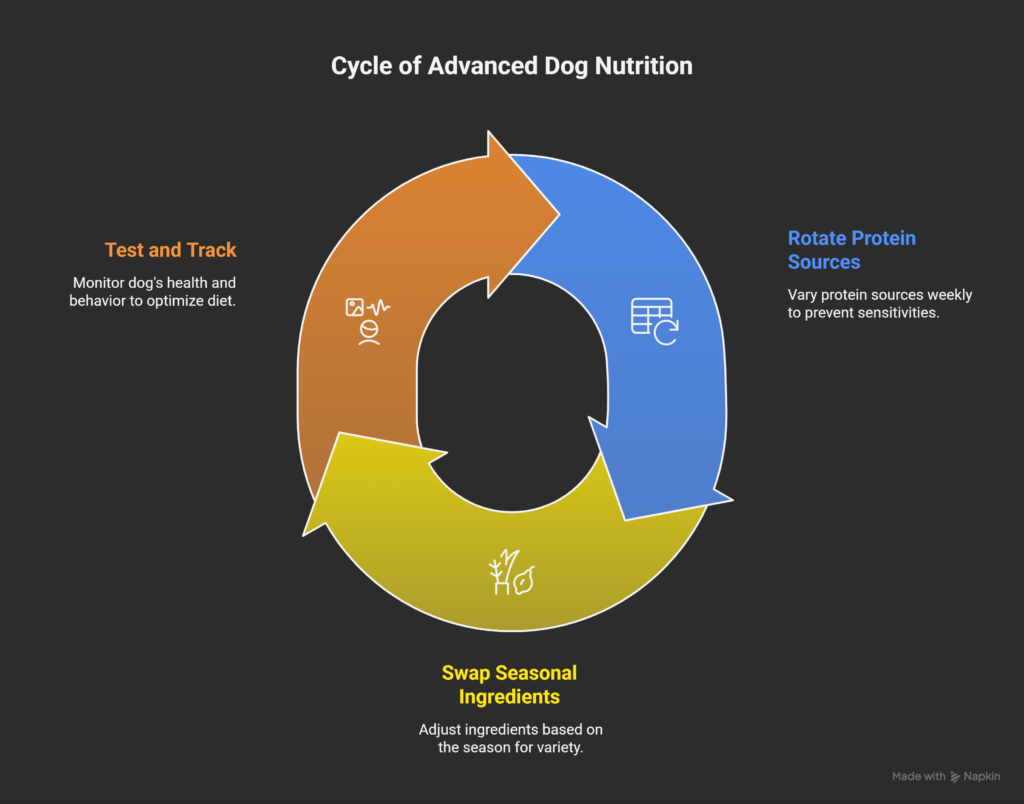
Once you’ve mastered the basics, here are some pro-level strategies to take your dog’s nutrition to the next level.
Rotation Diet Benefits
Instead of feeding the same recipe every day, rotate between different protein sources throughout the week. This prevents food sensitivities and provides a wider range of nutrients.
Sample weekly rotation:
- Monday/Tuesday: Chicken-based meals
- Wednesday/Thursday: Beef-based meals
- Friday/Saturday: Fish-based meals
- Sunday: Turkey or lamb
Seasonal Ingredient Swaps
- Summer: Add cooling foods like cucumber and melons
- Winter: Include warming spices like ginger and cinnamon
- Spring: Fresh greens and lighter proteins
- Fall: Root vegetables and heartier meals
Testing and Tracking
Keep a simple food diary noting:
- What you fed
- Your dog’s energy levels
- Stool quality
- Any behavioral changes
This helps you identify which combinations work best for your specific pup.
Key Takeaways
Making homemade meat dog food isn’t rocket science, but it does require some planning and commitment. Here’s what you need to remember:
Start simple with basic recipes and gradually expand your repertoire. Your dog will appreciate the variety, and you’ll gain confidence in the kitchen.
Balance is everything – meat is crucial, but vegetables and carbohydrates play important supporting roles in your dog’s nutrition.
Transition slowly to avoid digestive upset, and don’t be afraid to adjust recipes based on your dog’s individual needs and preferences.
Quality ingredients matter just as much for your dog as they do for your family. Choose the best meat and produce you can afford.
Consistency pays off in the long run. Your dog’s health improvements will become more apparent over time, making all the effort worthwhile.
Remember, every dog is different. What works perfectly for one pup might need tweaking for another. Pay attention to your dog’s response and adjust accordingly – you know your furry friend better than anyone else!
Final Thoughts
Switching to homemade meat dog food has been one of the best decisions I’ve made for my dogs’ health and happiness. Sure, it takes more effort than opening a bag of kibble, but seeing the difference in their energy, coat quality, and overall well-being makes every minute of meal prep worth it.
Your dog trusts you to make the best choices for their health – and honestly, you’re already considering homemade food, which means you’re on the right track. Start with simple recipes, pay attention to your pup’s response, and don’t be afraid to experiment with different ingredients.
The bond you’ll build through preparing your dog’s meals with your own hands is just an added bonus. There’s something special about knowing exactly what goes into every bite your best friend takes. Plus, you’ll never have to worry about recalls or mysterious ingredients again – talk about peace of mind! 🙂
Frequently Asked Questions
Can I feed my dog raw meat in homemade recipes?
While some people choose raw diets, I personally prefer cooking meat to eliminate bacteria risks. Cooked meat is just as nutritious and much safer, especially if you’re new to homemade dog food. If you’re interested in raw feeding, definitely consult with a veterinary nutritionist first.
How long does homemade dog food keep in the fridge?
Homemade dog food stays fresh for 3-4 days in the refrigerator and up to 3 months in the freezer. I always make sure to portion meals into containers immediately after cooking and label them with dates. When in doubt, give it the sniff test – if it smells off to you, it’s probably not good for your dog either.
Is homemade dog food nutritionally complete?
A well-planned homemade diet can absolutely be nutritionally complete, but it does require some knowledge and possibly supplements. I recommend working with your vet or a veterinary nutritionist, especially when you’re starting out. They can help ensure you’re meeting all of your dog’s nutritional needs.
What if my dog has food allergies?
Homemade dog food is actually perfect for dogs with allergies because you control every single ingredient! Start with a single protein source your dog has never had before (like duck or venison) and add ingredients one at a time. This makes it super easy to identify and avoid problem foods.
Can puppies eat homemade meat dog food?
Puppies can definitely eat homemade food, but they have different nutritional requirements than adult dogs. They need more protein and calories for proper growth and development. I’d strongly recommend consulting with your vet about puppy-specific recipes to make sure you’re supporting healthy development.
What is the recommended amount of homemade dog food for a dog?
Generally, dogs need about 2-3% of their body weight in food per day, but this varies based on age, activity level, and metabolism. About 1 to 1.5 pounds of food would be consumed daily by a 50-pound dog. Start with this guideline and adjust based on your dog’s body condition – you should be able to feel their ribs without pressing hard, but not see them clearly.


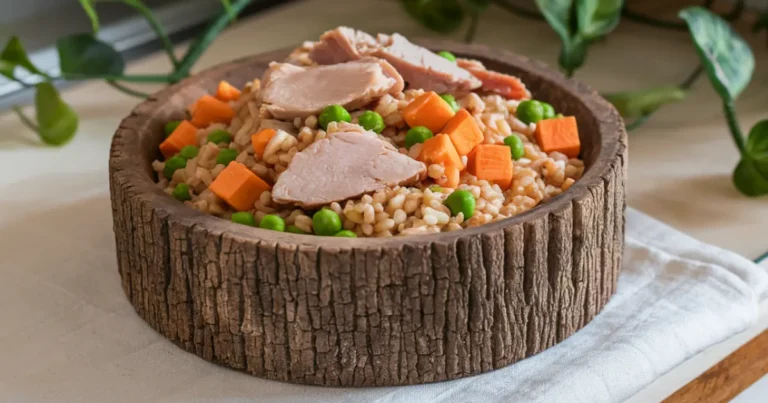
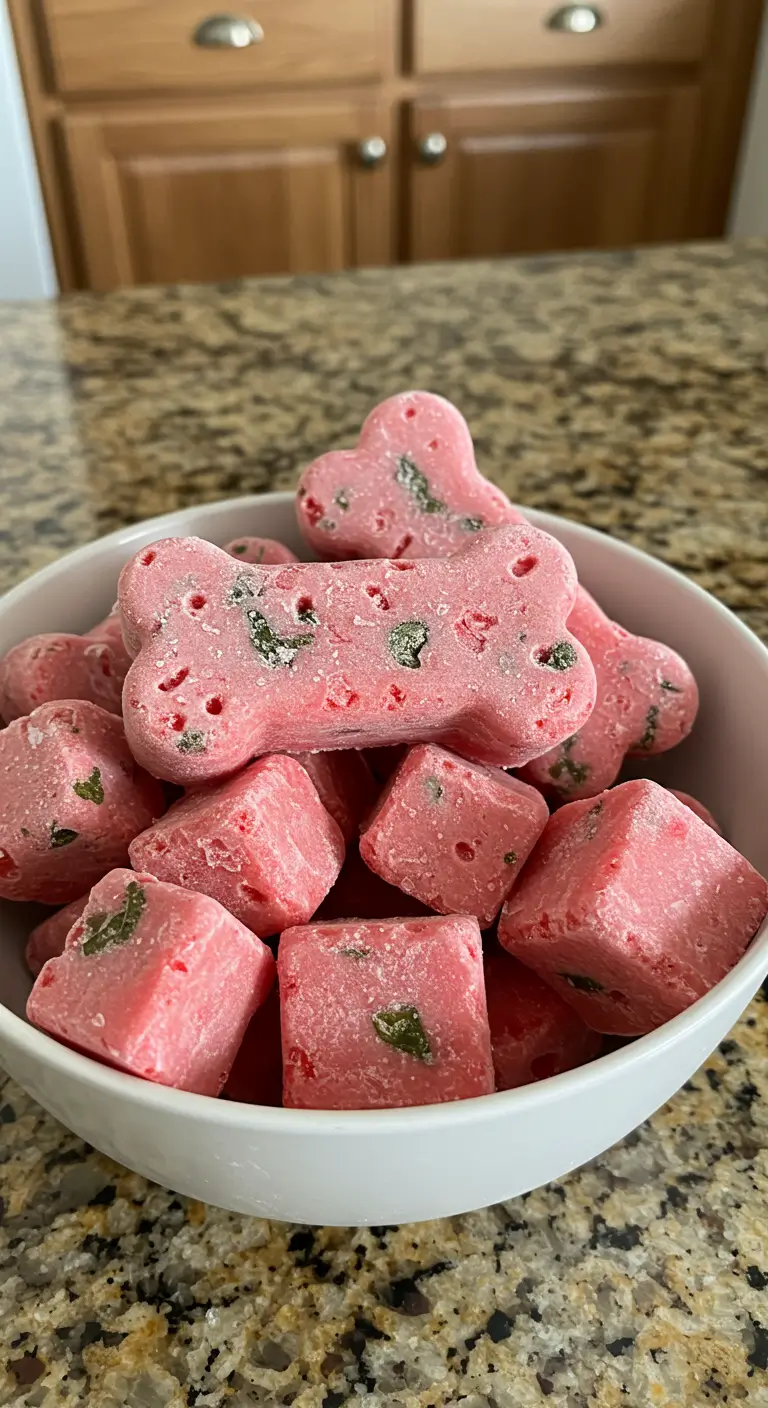




My brother recommended I might like this blog. He was totally right. This post truly made my day. You can not imagine simply how much time I had spent for this information! Thanks!